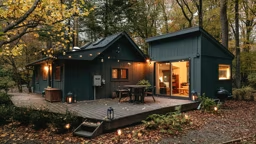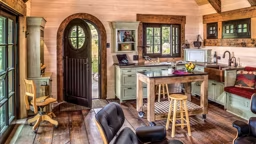Visualizing the Plan
Most floor plans are drawn so that 1/4 inch on the plan equals 1 foot in real life. You may struggle to imagine the real life version of your plan. But take heart, there are tricks you can use to better visualize your rooms.
A good place to start is by using a familiar, actual space as a reference. Perhaps there was a special family cabin in your past? Those boisterous meals at the football field-length dining table were great! Perhaps you would like a similar gathering spot in your new space.
On the other hand, you probably don’t feel sentimental about memories of wedging yourself into that tiny bathroom, especially when you and your eight cousins tried to share the same towel rack. So you may have multiple – and larger – bathrooms in mind.
Another trick to better visualize your floor plan is to create a mock room. Simply tape off the dimensions of the room in question, using existing walls where possible. Keep in mind that tape “walls” will make a room feel more open and thus larger than it really is. To get an even better understanding of your plan, add furniture or large boxes to simulate furnishings to the space. This technique is similar to constructing one of those indoor forts you made as a kid, but with no blanket roof required.
Living the Plan
Now comes the fun part. Spend some quality time fantasizing about your fabulous new vacation home. Really picture yourself living and playing there.
Uh-oh! Is the main entry crowded with supplies, luggage and guests during the Friday night invasion? A more gracious foyer or separate guest entrance may be the answer. Perhaps your weekend bliss comes from cooking a gourmet meal with a few good friends. A generous kitchen with multiple work spaces may be perfect for your needs. If you love the beach, an outdoor shower strategically located near a mudroom entry may help keep the grit where it belongs.
Mentally walk through your floor plan. Check for conflicting door swings and blind corners. Getting cold-cocked while en route to your morning coffee is not the best way to start the day.
Relationship Advice
That old real estate bromide about location, location, location also rings true for room placement and proximity. If you revel in outdoor entertainment, make sure your kitchen is located near your patio or deck. Sometimes overnight guests can be too much of a good thing. A guest wing physically apart from the master bedroom will increase privacy. If you anticipate very young visitors, a visible but separate playroom may make adult conversations possible.
Size Matters – A Lot
When people think of room size, spacious kitchens and generous bathrooms often come to mind. However, storage can be overlooked, and often becomes a frequent post-construction complaint. Make sure you have adequate space for all your prized possessions and other, well – stuff. If reading your collection of nature books while seated next to a flickering fire is your ideal evening, consider a fireplace surround with a built-in bookcase. If fishing is your passion, a conveniently placed, separate closet to stow gear may be just the thing.
Shape and layout matter as well. Screened porches are lovely, but avoid a long, skinny layout as it will force traffic down the center of the room, reducing functionality. Door layout within rooms is a critical consideration. Corner doors keep traffic to the outside of a room, easing furniture arrangement. They also provide more usable wall space.
Also beware of the potential for wasted space. An area under a stairway may be perfect for a pantry or built-in display shelves.
Windows on Your World
Windows can function as striking architectural details, portals for fresh air and natural light or frames for incredible views. There are virtually unlimited window choices on the market today. These choices can be overwhelming, but take your time. A beautiful window can make your room.
Window placement is another important consideration. How does light and air flow into your home? Imagine breathing in refreshing mountain air in a pleasantly sunny room. Keep in mind that a room with lots of wall space feels small, while windows to the great outdoors make a room feel larger.
Electrical Shock
Electrical outlets, switches and other data ports are generally not drawn on floor plans. Because of this, they are often overlooked and have the potential to cause large headaches during the building process.
Interior designer Melissa Hoffman of Studio M Designs in Littleton, Colo., advises her clients to create a detailed furniture plan. With her help, clients stroll through their plan, flip switches, answer the phone and turn on appliances.
Hoffman also recommends that clients think broadly in terms of their electrical and data needs. A security system can be indispensable in a vacation home. Wouldn’t it be nice to control it from the master bedroom? If you are in need of a remote office, don’t forget phone, fax and Internet connections. Of course, wireless electronics are fast becoming a popular alternative.
Hoffman knows personally the importance of considering electrical and data outlets: She recently purchased a home with a beautiful built-in TV cabinet. Unfortunately, the cable and electrical were across the room. It cost her $400 to correct the problem.
Cabin Sweet Cabin
The most cost-effective time to make design changes is while your floor plan is still on paper. So dream about your ultimate getaway home, clip inspiring magazine photos, visit reference cabins and take plenty of notes. Soon you will possess a floor plan that fits your fancy, and you will be that much closer to the getaway of your dreams.
Marti Jentz is thinking about a floor plan that will accommodate her growing family. She and her husband welcomed their third child in March.
Most floor plans are drawn so that 1/4 inch on the plan equals 1 foot in real life. You may struggle to imagine the real life version of your plan. But take heart, there are tricks you can use to better visualize your rooms.
A good place to start is by using a familiar, actual space as a reference. Perhaps there was a special family cabin in your past? Those boisterous meals at the football field-length dining table were great! Perhaps you would like a similar gathering spot in your new space.
On the other hand, you probably don’t feel sentimental about memories of wedging yourself into that tiny bathroom, especially when you and your eight cousins tried to share the same towel rack. So you may have multiple – and larger – bathrooms in mind.
Another trick to better visualize your floor plan is to create a mock room. Simply tape off the dimensions of the room in question, using existing walls where possible. Keep in mind that tape “walls” will make a room feel more open and thus larger than it really is. To get an even better understanding of your plan, add furniture or large boxes to simulate furnishings to the space. This technique is similar to constructing one of those indoor forts you made as a kid, but with no blanket roof required.
Living the Plan
Now comes the fun part. Spend some quality time fantasizing about your fabulous new vacation home. Really picture yourself living and playing there.
Uh-oh! Is the main entry crowded with supplies, luggage and guests during the Friday night invasion? A more gracious foyer or separate guest entrance may be the answer. Perhaps your weekend bliss comes from cooking a gourmet meal with a few good friends. A generous kitchen with multiple work spaces may be perfect for your needs. If you love the beach, an outdoor shower strategically located near a mudroom entry may help keep the grit where it belongs.
Mentally walk through your floor plan. Check for conflicting door swings and blind corners. Getting cold-cocked while en route to your morning coffee is not the best way to start the day.
Relationship Advice
That old real estate bromide about location, location, location also rings true for room placement and proximity. If you revel in outdoor entertainment, make sure your kitchen is located near your patio or deck. Sometimes overnight guests can be too much of a good thing. A guest wing physically apart from the master bedroom will increase privacy. If you anticipate very young visitors, a visible but separate playroom may make adult conversations possible.
Size Matters – A Lot
When people think of room size, spacious kitchens and generous bathrooms often come to mind. However, storage can be overlooked, and often becomes a frequent post-construction complaint. Make sure you have adequate space for all your prized possessions and other, well – stuff. If reading your collection of nature books while seated next to a flickering fire is your ideal evening, consider a fireplace surround with a built-in bookcase. If fishing is your passion, a conveniently placed, separate closet to stow gear may be just the thing.
Shape and layout matter as well. Screened porches are lovely, but avoid a long, skinny layout as it will force traffic down the center of the room, reducing functionality. Door layout within rooms is a critical consideration. Corner doors keep traffic to the outside of a room, easing furniture arrangement. They also provide more usable wall space.
Also beware of the potential for wasted space. An area under a stairway may be perfect for a pantry or built-in display shelves.
Windows on Your World
Windows can function as striking architectural details, portals for fresh air and natural light or frames for incredible views. There are virtually unlimited window choices on the market today. These choices can be overwhelming, but take your time. A beautiful window can make your room.
Window placement is another important consideration. How does light and air flow into your home? Imagine breathing in refreshing mountain air in a pleasantly sunny room. Keep in mind that a room with lots of wall space feels small, while windows to the great outdoors make a room feel larger.
Electrical Shock
Electrical outlets, switches and other data ports are generally not drawn on floor plans. Because of this, they are often overlooked and have the potential to cause large headaches during the building process.
Interior designer Melissa Hoffman of Studio M Designs in Littleton, Colo., advises her clients to create a detailed furniture plan. With her help, clients stroll through their plan, flip switches, answer the phone and turn on appliances.
Hoffman also recommends that clients think broadly in terms of their electrical and data needs. A security system can be indispensable in a vacation home. Wouldn’t it be nice to control it from the master bedroom? If you are in need of a remote office, don’t forget phone, fax and Internet connections. Of course, wireless electronics are fast becoming a popular alternative.
Hoffman knows personally the importance of considering electrical and data outlets: She recently purchased a home with a beautiful built-in TV cabinet. Unfortunately, the cable and electrical were across the room. It cost her $400 to correct the problem.
Cabin Sweet Cabin
The most cost-effective time to make design changes is while your floor plan is still on paper. So dream about your ultimate getaway home, clip inspiring magazine photos, visit reference cabins and take plenty of notes. Soon you will possess a floor plan that fits your fancy, and you will be that much closer to the getaway of your dreams.
Marti Jentz is thinking about a floor plan that will accommodate her growing family. She and her husband welcomed their third child in March.
Are constant daydreams of that new cabin or cabin addition interfering with work and family? You own property, but you’re looking to build, rebuild or add on. The possibilities are bewildering, fueling those daydreams.
Take a step toward peace of mind: Develop a floor plan with an architect or home builder, or obtain an existing plan from them or a plan book. It’s the first step in bringing your dreams to life.
A floor plan is a bird’s-eye view drawing of a home’s layout. Builders, residential architects and interior designers use floor plans (along with site, elevation and detail drawings) to design and ultimately build homes.
Typically, floor plans show interior and exterior walls, doors, windows, kitchen appliances, bathroom fixtures, fireplaces, laundry appliances, mechanical equipment and support columns. Standard symbols are used to represent these items.
You don’t have to be an expert to read a floor plan, but you do need to understand the symbols – and there are hundreds of them. Ask your floor plan provider if you have any questions. After all, what layperson knows the symbol for a gas clothes dryer?
Take a step toward peace of mind: Develop a floor plan with an architect or home builder, or obtain an existing plan from them or a plan book. It’s the first step in bringing your dreams to life.
A floor plan is a bird’s-eye view drawing of a home’s layout. Builders, residential architects and interior designers use floor plans (along with site, elevation and detail drawings) to design and ultimately build homes.
Typically, floor plans show interior and exterior walls, doors, windows, kitchen appliances, bathroom fixtures, fireplaces, laundry appliances, mechanical equipment and support columns. Standard symbols are used to represent these items.
You don’t have to be an expert to read a floor plan, but you do need to understand the symbols – and there are hundreds of them. Ask your floor plan provider if you have any questions. After all, what layperson knows the symbol for a gas clothes dryer?

 Richard Gerstner, istock.com
Richard Gerstner, istock.com 









